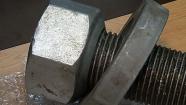
How could it happen? Over 2,000 bolts used in the new San Francisco-Oakland Bay Bridge are at risk of failure. The bolts were galvanized to make them harder; oddly they are too hard. This was discovered by accident when recently installed bolts cracked after being tightened. Unfortunately, huge numbers of bolts had already been installed in critical areas; they hold the roadbed to the pillars, the suspension cables to the tower, and the cables to the roadbed. Some of the critical bolts are embedded in the concrete pillars and cannot be replaced. Thirty-two high-strength steel bolts that cracked were embedded in seismic stabilizers. The new bridge was being built to provide seismic stability, which is now being called into question.
A bridge of high importance to the safety of public, was designed to last over 100 years and sustain earthquakes over 8.0 is now a failure. It is certainly more beautiful, will carry more traffic than today’s bridge and will be safer for drivers. However, number one reason for building the new bridge was to ensure structural safety in the event of a major earthquake.
Violated Own Rules
A $6 billion project, high visibility, and three oversight committees – how could this happen? There aren’t any signs that this was malicious. The simple answer is that people don’t care about their work any more. No one cared enough to question or check on the violation of bridge standards. No one looked closely at the details. One source said that CalTrans, the state transportation agency responsible for building the bridge, overrides their own rules and national standards all the time because what they build is unique. That may be true, but violating standards and rules consistently means that effectively there are no rules or standards.
What is missing is a process for checking why rules are overridden. The process includes confirming the reasons for overriding rules with intelligent sources, delineating the pros and cons, and obtaining approval from individuals who are responsible for the project’s overall success. With so many groups monitoring the project, did they all think that the other groups would catch problems? Questions were not asked.
CalTrans claims a communication was sent to the manufacturer saying the bolts were not to be hardened beyond a specific level. The manufacturer says they never received any communication. Why didn’t anyone follow-up to ensure the communication was received and understood on a specification that was important to the integrity of the entire bridge structure? Sloppy work. Not by one person but by a lot of people. The investigation isn’t finished yet, but so far no internal memo that questions the bolt specs has been discovered.
Basic Mistake
A less public example of the lack of quality control on the bridge is in the bolts that hold the railings on the bicycle path sheared off last year. Those bolts are required to move slightly to accommodate the expansion and contraction that occurs during weather changes. Workers welded the bolts on the bike path railings so they could not move when the deck expanded causing them to shear off. Fastening the bike path bolts is a simple straightforward task once it is understood how the bolt works in the expansion joint. Experts say that this was a basic mistake. But who was responsible for making sure the workers knew what to do? The bicycle bolt problem was discovered last year. The entire length of the bike path had been improperly bolted without a single quality person checking and finding the error the entire time.
Pattern of Error
The oversight groups should have questioned why this happened. They might have discovered that the same lack of oversight before the seismic bolts were installed. There are construction safety engineers. Where were they? Basic mistakes are indicative of larger issues in complex mega-projects. The question is what other error occurred that are still unknown.
Reviews are Critical
There are many places where large complex projects can go wrong. That’s why reviews and audits are built into the project timetable. This is when questions are asked, critical points are gone over and double-checked to avoid failure. On large projects, audits by an objective party are a requirement. They are the safety engineers for your project. Check your projects to make sure that your safety checks have not been overridden without sound reasons and that exceptions don’t jeopardize the project’s success.


Leave A Comment
You must be logged in to post a comment.